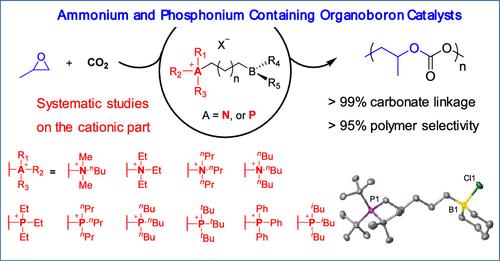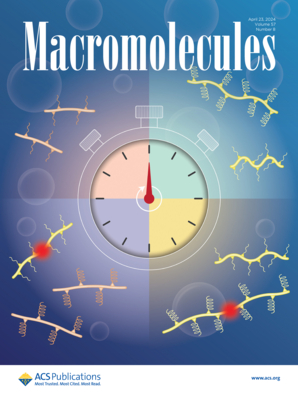Rational Optimization of Ammonium and Phosphonium Cations of Bifunctional Organoborane Catalysts for Copolymerization of Propylene Oxide with CO2 to Afford Poly(propylene carbonate)
IF 5.2
1区 化学
Q1 POLYMER SCIENCE
引用次数: 0
Abstract
Ring-opening copolymerization (ROCOP) of CO2 and propylene oxide (PO) is a challenging task due to its tendency to generate a polyether linkage and cyclic carbonate. Our group recently reported a series of mononuclear organoborane catalysts for the efficient ROCOP of CO2 with cyclohexene oxide (J. Am. Chem. Soc., 2020, 142, 12245–12255), but only cyclic carbonate was obtained during the copolymerization of CO2 with PO (Angew. Chem. Int. Ed. 2020, 59, 23291–23298). By modulating the cationic part of the catalysts, herein, we upgraded our previous borinane-based and 9-BBN-based mononuclear organoborane catalytic systems and successfully realized the alternating CO2/PO copolymerization to produce poly(propylene carbonate) (PPC) with >99% selectivity. Optimal catalytic performance was achieved by catalysts bearing alfa-H (αH) atoms in Et3, nPr3, and nBu3 substituents for both ammonium and phosphonium cations. Notably, catalysts featuring a cation without an αH atom (even with beta-H, βH) exhibited inferior performance in both catalytic activity and PPC selectivity, suggesting the indispensable role of αH atoms of cations. An intramolecular αH atom-dominated interaction over βH, which is useful to suppress the backbiting side reaction and to facilitate chain propagation, was therefore proposed. Further, the 31P NMR spectra study indicated that the superior catalytic activity of phosphonium-based catalysts than its ammonium counterparts stems from the stronger Lewis acidity of the catalyst molecule imparted by the phosphonium cation. We believe the insights into the optimization of the cationic part of organoborane catalysts could inspire more advanced catalysts in the future.

合理优化双功能有机硼烷催化剂中的铵和鏻阳离子,用于氧化丙烯与二氧化碳共聚生成聚(碳酸丙烯酯)
二氧化碳与环氧丙烷(PO)的开环共聚(ROCOP)是一项具有挑战性的任务,因为它容易生成聚醚链和环状碳酸盐。我们的研究小组最近报告了一系列单核有机硼烷催化剂,用于 CO2 与环己烯氧化物的高效 ROCOP(J. Am. Chem. Soc., 2020, 142, 12245-1225),但在 CO2 与 PO 的共聚过程中仅获得了环碳酸盐(Angew.)通过调节催化剂的阳离子部分,我们升级了之前的硼烷基和 9-BBN 基单核有机硼烷催化体系,成功实现了 CO2/PO 交替共聚,以 99% 的选择性生产出聚碳酸丙烯酯 (PPC)。在铵和鏻阳离子的 Et3、nPr3 和 nBu3 取代基中含有 alfa-H (αH) 原子的催化剂实现了最佳催化性能。值得注意的是,含有不含 αH 原子的阳离子(即使含有β-H、βH)的催化剂在催化活性和 PPC 选择性方面都表现较差,这表明阳离子的 αH 原子起着不可或缺的作用。因此,有人提出了一种分子内 αH 原子比 βH 原子更主要的相互作用,这种作用有利于抑制背驰副反应并促进链的扩展。此外,31P NMR 光谱研究表明,鏻基催化剂的催化活性优于铵基催化剂,这是因为鏻阳离子赋予了催化剂分子更强的路易斯酸性。我们相信,对有机硼烷催化剂阳离子部分优化的深入研究将为未来开发更先进的催化剂提供灵感。
本文章由计算机程序翻译,如有差异,请以英文原文为准。
求助全文
约1分钟内获得全文
求助全文
来源期刊

Macromolecules
工程技术-高分子科学
CiteScore
9.30
自引率
16.40%
发文量
942
审稿时长
2 months
期刊介绍:
Macromolecules publishes original, fundamental, and impactful research on all aspects of polymer science. Topics of interest include synthesis (e.g., controlled polymerizations, polymerization catalysis, post polymerization modification, new monomer structures and polymer architectures, and polymerization mechanisms/kinetics analysis); phase behavior, thermodynamics, dynamic, and ordering/disordering phenomena (e.g., self-assembly, gelation, crystallization, solution/melt/solid-state characteristics); structure and properties (e.g., mechanical and rheological properties, surface/interfacial characteristics, electronic and transport properties); new state of the art characterization (e.g., spectroscopy, scattering, microscopy, rheology), simulation (e.g., Monte Carlo, molecular dynamics, multi-scale/coarse-grained modeling), and theoretical methods. Renewable/sustainable polymers, polymer networks, responsive polymers, electro-, magneto- and opto-active macromolecules, inorganic polymers, charge-transporting polymers (ion-containing, semiconducting, and conducting), nanostructured polymers, and polymer composites are also of interest. Typical papers published in Macromolecules showcase important and innovative concepts, experimental methods/observations, and theoretical/computational approaches that demonstrate a fundamental advance in the understanding of polymers.
 求助内容:
求助内容: 应助结果提醒方式:
应助结果提醒方式:


